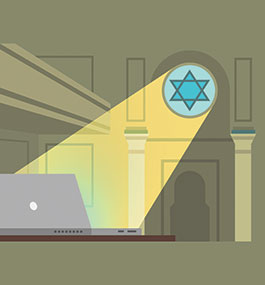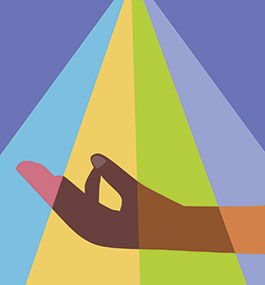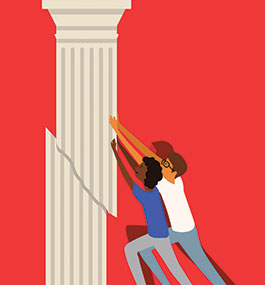Past as Prologue
Hazarding a few bold guesses, Brandeis faculty forecast what their field will look like in 25 years.

Nick Lu
On the occasion of Brandeis’ 75th anniversary, we asked a cross section of faculty to imagine the contours of their field 25 years from now, when the university turns 100. Overcoming their natural hesitation to cast themselves as seers, they offered thoughtful ideas, invariably punctuated with some version of “But who the heck knows?”
The insights of these professors are revealing. So is their obvious dedication to their field, a deep commitment that makes Brandeis a unique place to teach and learn.
Which is, of course, great news for the future.
* * * * * *
A Rapidly Changing Media Landscape
By Neil Swidey
Journalists may write the first draft of history, but they wade into prophecy at their own peril. To get a handle on what journalism may be like a quarter of a century from now, it’s helpful to look back in time.
Two decades ago, before Google went public, I logged lots of reporting hours at its headquarters, exploring the question of whether the company would transform our concept of privacy. Co-founder Sergey Brin breezily assured me everything would be fine, falling back on the information-wants-to-be-free lingua franca of Silicon Valley. (He did seem unsettled when I told him I had dug up his date of birth. That kind of info was still hard to find.) Around the same time, I hung out in MIT’s Media Lab, listening to the best and brightest foretell the coming Web 2.0.
What strikes me today is how eerily accurate these tech evangelists were in predicting the rise of social media — and how completely they missed the enormous drawbacks that accompanied this shift.
Techies need more of journalism’s hallmark skepticism, and journalists could use more of the tech world’s hard-wired optimism. After all, few journalists foresaw the resurgence of radio in the 1980s and ’90s (when NPR was a chief beneficiary of longer commute times in U.S. metro areas). Even fewer predicted the explosion of podcasting. And as recently as 2010, newsroom office pools were offering long odds that The New York Times would survive another decade, never mind emerge bigger and more profitable than ever.
In the Brandeis journalism program, which has seen a dramatic spike in interest, we’re preparing our students to adapt to the rapidly changing media landscape.
I offer up measured hopes for journalism over the next quarter century. May quality local news outlets see a radio-like resurgence, with today’s independent digital startups building into a wave of success, in communities from coast to coast. And may a critical mass of Americans finally tire of our awful Fox News-versus-MSNBC drift toward affirmation rather than information, and once again turn to national news outlets that give us all a common set of facts.
If this happens by the middle of the century, we’ll have a lot more than Brandeis’ centennial to celebrate.
Professor of the practice Neil Swidey directs the journalism program.

Nick Lu
page 2 of 8
American Judaism Goes Online
By Jonathan D. Sarna ’75, GSAS MA’75
COVID-19 was the great accelerator of all things digital. Suddenly, millions quarantined at home discovered the digital wonders that connected them virtually. Synagogues, temples, and Jewish organizations of every sort shifted worship services, classes, lectures, and Passover Seders to Zoom.
Three years later, digitization has transformed American Judaism. Though it’s safe to worship in person, thousands continue to worship online, sometimes abandoning local congregations for professionally produced online services streamed from big-city synagogues miles away.
On-site educational and cultural programs are declining at synagogues. Online ones are thriving — no more need for child care, appropriate clothes, and long drives home. Now one can access classes, rabbis, and world-famous lecturers with just a few keystrokes.
Jewish learning has also been democratized. Books and source materials once found mostly in great rabbinic libraries can be accessed by anyone, thanks to websites like Sefaria and HebrewBooks.org.
Attendance at life-cycle ceremonies has benefited from the digital revolution. Sick or out of town? Instead of missing out on baby namings, bnai mitzvah, weddings, and funerals, one can now join them virtually. Last summer, I myself Zoomed in from Israel to witness the circumcision of one of my grandsons.
The impact of the print revolution on Judaism unfolded over hundreds of years. So it’s still much too early to gauge the long-term impact of the digital revolution on American Judaism.
This much, however, is clear: The digital revolution is redefining numerous aspects of Judaism and Jewish life. Whoever teaches the history of American Judaism when Brandeis turns 100 will need to pay this revolution close attention.
University Professor Jonathan D. Sarna is the Joseph H. and Belle R. Braun Professor of American Jewish History, and the author of “American Judaism: A History.”

Nick Lu
page 3 of 8
No Death Knell for Religion
By Kristen Lucken and Wendy Cadge
Considering the future of religion, where the puzzle pieces move as part of dynamic social forces and rarely move linearly, is complex.
In the United States, people are leaving organized religion. The number of Americans who claim no religious affiliation has been rising across generations for at least 10 years. Yet, rather than joining the ranks of nonbelievers, young adults increasingly identify as “spiritual but not religious.”
A similar number of millennials say religion is very important to them.
Religion is not dying. It will continue to change, we suspect, around the axes of disaffiliation, diversity, and discrimination. Entrepreneurs are offering spiritual content in new packages. Locally and globally, religion is being used as a force to both maintain the status quo and stimulate change.
Religion also remains an essential expression of racial and ethnic identity. Nonwhite students in the U.S. report high levels of religious affiliation, including 87% of African Americans, 81% of Latinos, and 73% of Asians.
As some traditional religious groups decline, newcomers to America are bringing vibrancy to the religious landscape. Immigrant religious institutions become de facto ethnic community centers, where people connect with one another over shared holidays and celebrations.
Around the globe, antisemitism, Islamophobia, and religious nationalism are on the rise, and high levels of government intervention in religion — including discriminatory policies that protect “traditional” cultures and religions — are correlated with increased social hostilities and religious violence.
Over the years ahead, people will shape and adapt religion in predictable and unexpected ways, fueled by continually shifting demographics. The number of people who identify as Christian could be as low as 50% of the U.S. population by 2070, while non-Christian religions could double in size, to approximately 12% of the U.S. population.
Kristen Lucken is a lecturer in international and global studies, religious studies, and sociology. Wendy Cadge is the Barbara Mandel Professor of the Humanistic Social Sciences and the dean of the Graduate School of Arts and Sciences.

Nick Lu
page 4 of 8
American Democracy in Peril
By Robert Kuttner
America barely survived the Trump administration’s multiple assaults on democracy.
Our norms and institutions are still imperiled. In addition to the obvious threats — the efforts to suppress voting and overturn elections, sometimes by violent force — one of our two major parties now dwells in a universe where evidence doesn’t matter. Some Republicans are frank admirers of neofascism. The captivity of House Republicans to their most extreme far-right faction only adds to the peril.
The sane, competent Biden administration understands Trumpism was seeded by a steady decline in working-class Americans’ economic prospects. The administration has made expansive use of federal investment and regulation to improve working families’ lives, more so than any administration since Franklin Roosevelt’s. Yet Joe Biden does not get full political credit for this, partly because his most transformative programs were blocked by Congress and partly because many voters believe he’s too old for the job of president.
Meanwhile, the sheer extremism and fragmented leadership of the Republicans is damaging their appeal, so much so that the contest for the 2024 Republican presidential nomination might become a self-destructive demolition derby. Thanks to Republican extremism on issues ranging from the destruction of reproductive rights to gutting Social Security, Democrats fared a lot better in the 2022 midterms than most commentators projected, picking up a Senate seat and nearly holding the House of Representatives.
Even if America dodges another bullet in the 2024 elections, I worry about the ever more extreme concentration of corporate monopoly, and the deepening concentration of wealth and political power, which come at the expense of ordinary working people. The Democrats’ failure to challenge that 40-year trend allowed Donald Trump to pose as a faux populist, using racist nationalism to conceal a corporate governing agenda.
So the revival of liberal democracy, while necessary, is not sufficient. A radical restoration of economic democracy is also required.
Robert Kuttner is the Heller School’s Meyer and Ida Kirstein Professor in Social Planning and Administration.

Nick Lu
page 5 of 8
From Black Studies to Everybody’s Studies
By Chad Williams
The question of where African and African American studies will be in 25 years pulls me back to another commemorative moment.
In February 2019, Brandeis’ African and African American studies department celebrated its 50th anniversary. The historic two-day gathering featured alumni panels, which included participants in the 1969 Ford Hall occupation; a conversation between Angela Davis ’65 and Julieanna Richardson ’76, H’16; and a closing keynote address by Hortense Spillers, GSAS PhD’74, who also received an Alumni Achievement Award.
Spillers, who was part of the Ford Hall occupation, reflected on the evolution of African and African American studies, and its impact on intellectual history — how “a moment of protest becomes a curricular object,” as she put it. More than any other field of inquiry, the discipline has been responsible for excavating the richness of Black life, and making race both visible and legible, she said.
But Spillers acknowledged the discipline was “not entirely clear of danger even today,” pointing to “the forces of race hatred and revanchism, and their quite astonishing powers of renewal and quite impressive shape-shifting capacity.”
She concluded with a poignant question: “Are we bound for the day when Black studies are everybody’s studies?”
In 25 years, Black studies will have grown in intellectual sophistication and curricular innovation, and will remain at the forefront of shaping our understanding of Black life, in the academy and beyond.
Those who fear Black studies and believe it has no place in American education will remain persistent in their efforts to attack the discipline and those who practice it.
Nevertheless, the same visionary spirit of creation, perseverance, and commitment to transforming the world that led to the creation of Brandeis’ AAAS department in 1969 will propel Black studies into the future, a future in which Black studies will inevitably be everybody’s studies.
Chad Williams is the Samuel J. and Augusta Spector Professor of History, and African and African American Studies.

Nick Lu
page 6 of 8
Across Boundaries
By Ulka Anjaria
The excitement Brandeis students and my own high school-age children bring to literature and film, and their curiosity about the world around them suggest an emerging generation of adults with a deeply humanistic mind-set.
Will this mind-set change the course of history? I don’t know, but I have cause for hope. As the world continues to move in frightening, even apocalyptic directions, perhaps this new generation will develop tools that can reverse these trends.
Here are my humble hopes for the future:
- We will continue to read — and read widely, across more borders — not limiting ourselves to already familiar worlds.
- We will forge real human bonds across borders, by traveling to the places we read about.
- More of us will become multilingual, learning one or two additional languages, and reading and watching in
multiple languages. - More of us will become translators, and more translations will be published.
- We will watch more international cinema, from art films to popular movies. We will rely on subtitles rather than dubbing, to hear the sounds and cadences of other languages.
- Global humanism will spread and deepen, defying increasingly rigid borders that constitute much of global politics. (OK, this might not happen. But one can dream.)
Ulka Anjaria is a professor of English and the director of the Mandel Center for the Humanities.

Nick Lu
page 7 of 8
Protecting the Health of Aging Brains
By Christine Grienberger
Genetic studies have suggested a peptide called amyloid-β plays a primary role in Alzheimer’s disease, the incurable disorder that affects millions of Americans, most of them 65 and older. Yet treatment strategies targeted at reducing amyloid-β have proved largely unsuccessful, indicating the cognitive decline associated with Alzheimer’s likely results from a more complex pathophysiology.
The development of successful treatments for Alzheimer’s has been complicated by the fact that memory loss and other cognitive symptoms emerge late in the disease progression, making early diagnosis challenging.
Over the next 25 years, I believe a vastly improved understanding of the disorder’s complexity will yield novel therapeutic strategies as well as new methods of early diagnosis. For example, biomarkers of early, perhaps even pre-clinical Alzheimer’s disease could one day be found through neuroimaging screenings, or via cerebrospinal-fluid or blood analyses.
A multitiered approach to treating Alzheimer’s disease will probably become the standard of care. Treatments that reduce amyloid-β levels may stop the cascade that triggers single-cell dysfunction and nerve-cell death; such treatments will be especially important for people with familial Alzheimer’s, in which genetic mutations induce the overproduction of amyloid-β. And the restoration of cognition and brain health will probably depend upon therapeutic drugs that regulate brain activity and stimulate neuronal communication, improving the function of long-range brain networks.
My lab at Brandeis is working to understand the fundamental processes underlying memory and memory loss. Our findings may lead to treatments that can improve memory function and cell health, paving the way to a healthy aging brain.
Christine Grienberger is an assistant professor of biology.

Nick Lu
page 8 of 8
An Epic Future
By Joel Christensen ’01, GSAS MA’01
At Brandeis’ founding, the scholars who had fled Europe and the students who joined them were, by and large, inheritors of “great books” traditions, sharing cultural frameworks that included the Hebrew Bible and Homer’s “Iliad.”
At the time, few scholars were ready to question whether these traditions contributed to the death and destruction of the 20th century. But philosopher Simone Weil did. In her famous essay “The Iliad, or The Poem of Force” (1939), she worried that violence had become an inevitable — yet somehow invisible — centerpiece of Western civilization.
For the rest of the 20th century, the study of the classics — and of literature in general — engaged with the different ways of seeing, being, and telling the story of the world. We are still struggling to find some balance between preserving the study of the past as it used to be and welcoming into our classrooms different cultures and perspectives on human nature. At the same time, in the wake of new technology and changing expectations, educators are being asked to do more, move faster, and engineer and code the world to come.
Our fields must reckon with how our intellectual traditions have excluded some peoples and privileged others. And we must center fundamental questions in our work: What does it mean to be human? What is the value of our lives? How do we make — or, given climate change, preserve — a world we want to live in together?
At Brandeis, my discipline was once part of a well-known Mediterranean studies program. We have moved back in that direction — from classical studies to classical and early Mediterranean studies — to reconsider the boundaries of how we study the ancient world.
This doesn’t mean Homer won’t be read at Brandeis 25 years from now. To the contrary, the Homeric epics show a deep commitment to seeing humanity from different angles, examining the lives and experiences of both the Trojans and the Greeks.
But the Homeric epics will share space with ancient narratives from all over the world that reveal who we are and from whom we come. Engaging in this study together can help us, as Simone Weil said, “learn that there is no refuge from fate, learn not to admire force, not to hate the enemy, nor to scorn the unfortunate.”
Joel Christensen is a professor of classical studies.
